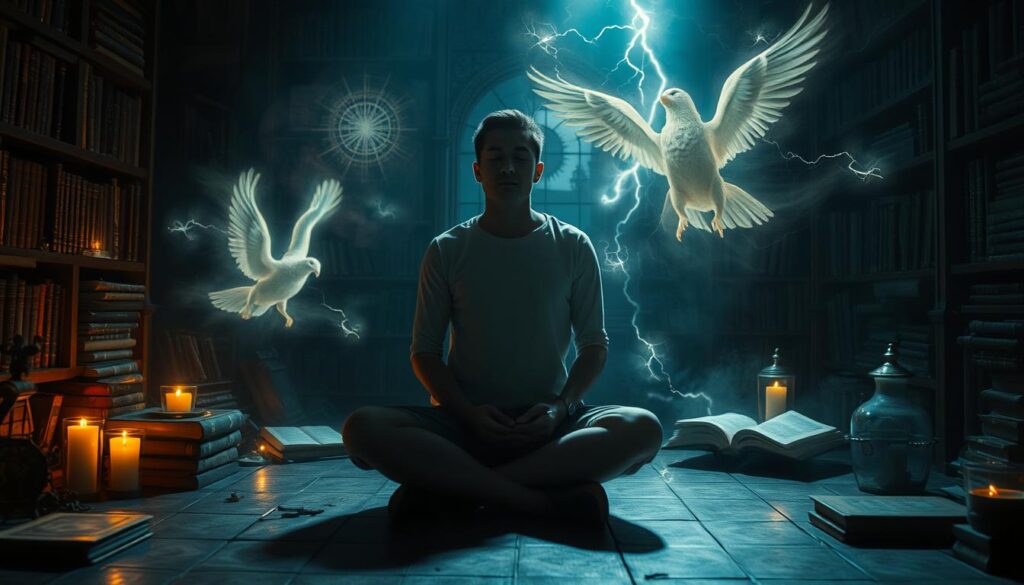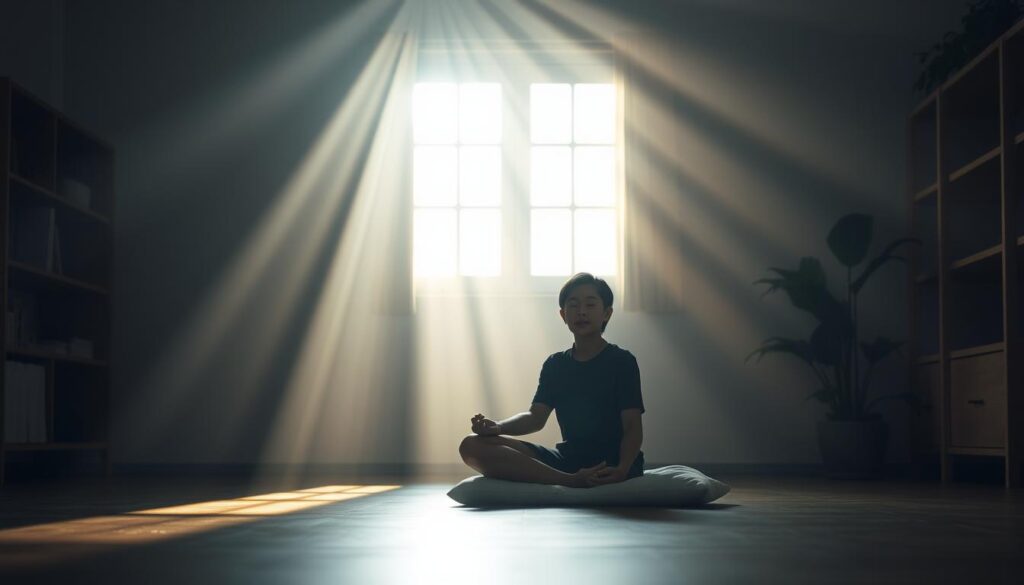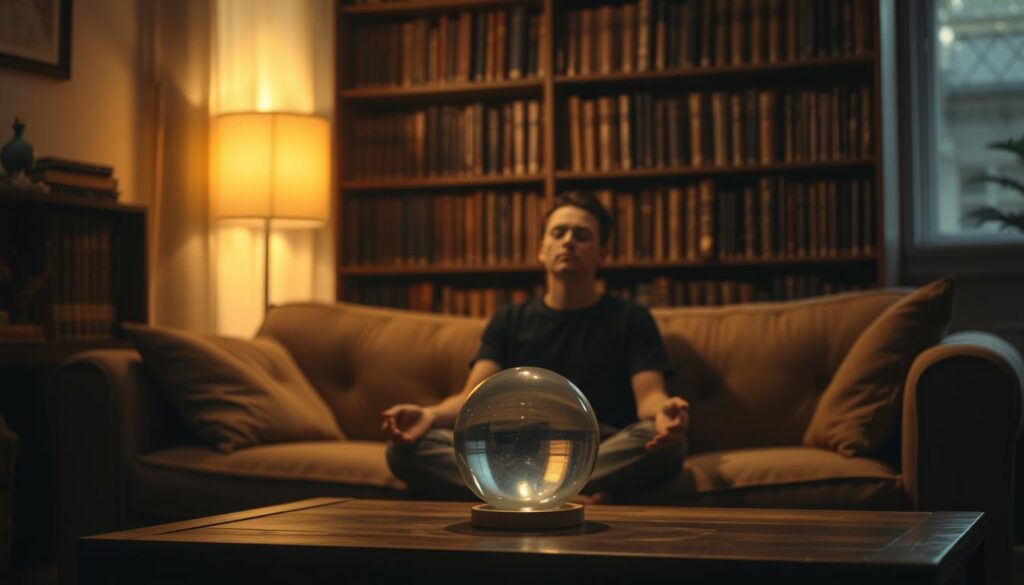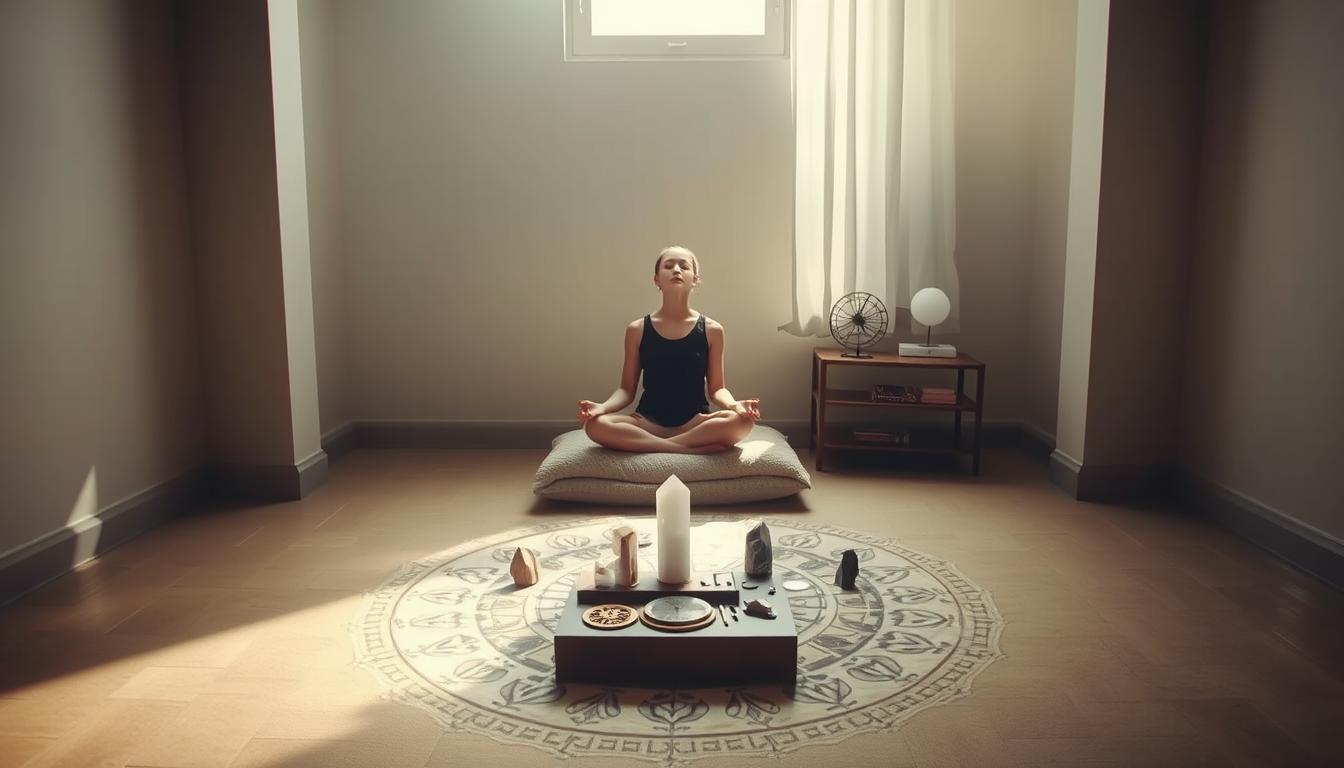Have you ever wondered if you could tap into abilities beyond the ordinary? The skill of accessing non-local information, often referred to as remote viewing, is something anyone can learn. It’s not just for the gifted—it’s a practice that can be developed with time and effort.
Historically, this ability was even explored by the CIA during classified programs. Today, it’s more accessible than ever for beginners. The key lies in understanding that 80% of sensory input is generated by the mind. This means attuning yourself to subtle cues is essential.
In this guide, we’ll explore foundational techniques like envelope targets and Controlled Remote Viewing (CRV). These methods are designed to help you sharpen your focus and enhance your intuitive skills. Remember, the goal is self-discovery, not perfection. Embrace the journey and enjoy the process.
Key Takeaways
- Remote viewing is a learnable skill for accessing non-local information.
- It was historically used in CIA programs and is now accessible to beginners.
- 80% of sensory input is brain-generated, requiring attunement to subtle cues.
- Foundational exercises include envelope targets and Controlled Remote Viewing (CRV).
- Focus on self-discovery rather than perfection.
What Is Remote Viewing?
What if you could access information beyond your physical senses? This is the essence of remote viewing, a skill often described as “anomalous cognition.” It allows individuals to perceive details about people, places, or events without being physically present.
Unlike natural psychic gifts, this ability is trainable. With practice, anyone can develop the skill to tap into non-local information. It’s not about being born with a special talent—it’s about learning to focus your mind and interpret subtle cues.

The history of remote viewing is fascinating. During the Cold War, the CIA funded studies at the Stanford Research Institute from the 1970s to 1995. Pioneers like Ingo Swann conducted groundbreaking experiments, such as accurately describing weather patterns thousands of miles away. These studies laid the foundation for modern understanding.
Real-world applications of this program include intelligence gathering and problem-solving. For example, it has been used to locate missing persons and uncover hidden details in complex situations. Gaia’s Mystery Teachings also offers practical techniques for those interested in exploring this skill further.
| Year | Event | Significance |
|---|---|---|
| 1970s | CIA-funded Stanford Research Institute studies | Established scientific foundation for remote viewing |
| 1973 | Ingo Swann’s weather viewing experiments | Proved the ability to perceive distant events |
| 1995 | Declassification of government programs | Made remote viewing accessible to the public |
Today, remote viewing continues to captivate those seeking to expand their knowledge of the world. Whether for personal growth or practical applications, it’s a skill that invites curiosity and exploration.
How Does Remote Viewing Work?
Ever wondered how your mind connects to distant places? The process of remote viewing relies on the subtle interplay between your conscious and unconscious mind. While your conscious mind processes about 50 bits of information per second, your subconscious handles a staggering 11 million bits. This vast difference allows your brain to pick up on faint signals that your conscious awareness might miss.
Your autonomic nervous system plays a key role in transmitting these subtle signals. Think of it as a bridge between your physical body and the unseen information around you. This system helps you tune into details that aren’t immediately obvious, like a radio picking up faint frequencies.

One common metaphor for this process is the “silver cord.” It represents the connection between your consciousness and the target you’re focusing on. Just as a cord links two points, your mind can bridge the gap between the physical and the intangible.
Remote viewing typically follows a three-phase process. First, you set your intention—what you want to explore. Next, you enter a meditative state to quiet your conscious mind. Finally, you interpret the impressions and feelings that arise. This structured approach helps you focus and decode the information your subconscious receives.
Scientific theories suggest that quantum entanglement might explain how this works. Just as particles can be connected across vast distances, your mind might tap into a similar phenomenon. While this is still a developing field, it offers fascinating possibilities for understanding the mind’s potential.
Preparing for Remote Viewing
Ready to explore the unseen? Preparation is key to unlocking your potential. Before you begin, it’s important to create the right environment and mindset. This ensures your sessions are productive and focused.

Setting the Right Environment
Your surroundings play a big role in your success. Start by choosing a quiet space, like a soundproof room or using noise-canceling headphones. Dim red lighting can reduce eye strain and help you stay relaxed.
Comfort is also crucial. Use a chair that supports your spine, keeping your back straight. Remove digital distractions, like phones or computers, to maintain focus. A calm environment sets the stage for better results.
Mental Preparation Techniques
Your mind needs to be ready too. Begin with a 15-minute preparatory meditation, keeping your back straight. This helps you enter a focused state. Try the box breathing technique—inhale for 4 seconds, hold for 7, and exhale for 8.
Progressive muscle relaxation can ease tension. Start from your toes and work up to your head. Visualize a white dot expanding into a tunnel, a method from Gaia’s astral journey teachings. Repeat a mantra like “Clear mind, open channels” to sharpen your focus.
These techniques help you manage emotions and enhance your skills. With consistent practice, you’ll be ready to explore with confidence.
Remote Viewing Exercises for Beginners
Curious about exploring your intuitive abilities? These beginner-friendly exercises are designed to help you sharpen your focus and enhance your skills. Each method offers a unique approach to tapping into non-local information, making it easier to get started.

Envelope Target Exercise
This exercise is perfect for beginners. Start by having an assistant curate diverse images from magazines, avoiding any traumatic content. Place these targets in sealed envelopes. During your session, focus on one envelope at a time.
Use a detailed sensory journaling protocol. Begin by noting textures before moving on to shapes. Visualize the scene from a bird’s-eye view, as suggested in Gaia’s instructions. This step-by-step approach helps you interpret subtle cues more effectively.
Coordinate Remote Viewing (CRV)
For a modern twist, try using Google Earth coordinates as your target. This method adapts traditional techniques to today’s technology. Focus on geographical locations and use temperature mapping to enhance your perception.
This exercise is particularly useful for exploring distant places. It encourages you to practice remote viewing in a structured way, making it easier to compare notes and track your progress.
Blind Matching Exercise
This method involves numbered envelopes containing pairs of natural and man-made objects. Start with simple single objects and gradually move to complex scenes. The progressive difficulty system ensures you’re always challenged.
Blind matching helps you refine your ability to interpret subtle details. It’s a great way to build confidence and improve your skills over time.
Tips for Successful Remote Viewing
Have you ever felt a subtle nudge guiding your thoughts? This could be your intuition at work. Developing your skills in this area requires trust and consistency. By following a few simple strategies, you can enhance your practice and achieve better results.

Trust Your Intuition
Your intuition is a powerful tool. It’s that quiet voice or gut feeling that often knows more than your conscious mind. To strengthen this ability, spend time each day tuning into your inner thoughts. Pay attention to subtle cues and trust what you feel, even if it doesn’t make immediate sense.
During your sessions, avoid overthinking. Let your mind flow freely and record your impressions without judgment. This approach helps you bypass analytical overlay, a common challenge where logic interferes with intuition.
Keep a Detailed Journal
Documenting your experiences is crucial for growth. CIA studies show that journaling can improve accuracy by 32%. Start by logging your feelings and impressions immediately after each session. Use color-coding to highlight confidence levels, making it easier to review later.
Try the “Three Pass Technique”: revisit your notes after one hour and again after 24 hours. This method helps you refine your interpretations and spot patterns over time. Additionally, track external factors like moon phases and biorhythms to identify potential influences on your results.
For a tactile approach, use tools like clay or textured paper to bypass visual bias. These methods can help you connect with your impressions in a new way, enhancing your overall skills.
Common Challenges and How to Overcome Them
Struggling to make sense of abstract impressions? You’re not alone. According to PEAR Lab stats, 68% of novices report frustration with unclear mental images. But don’t worry—there are practical ways to tackle these hurdles and improve your remote viewing skills.
One common issue is “foggy vision,” where details feel blurry or unclear. To combat this, try using citrus scents like lemon or orange. These scents stimulate the mind and enhance focus. Pair this with blue light exposure, which can sharpen mental clarity and reduce visual fatigue.

Another challenge is target fixation, where you get stuck on one detail and miss the bigger picture. Peripheral vision training can help. Practice focusing on objects in your surroundings without directly looking at them. This trains your mind to process information more holistically.
Doubt cycles can also derail your progress. Pre-session affirmation rituals, like repeating positive statements, can build confidence. For example, say, “I trust my intuition and connect with clarity.” This simple practice can shift your mindset and improve results.
A case study highlights the use of LEGO models to improve architectural accuracy. By physically building structures, participants enhanced their ability to visualize and interpret complex images. This hands-on approach bridges the gap between abstract thoughts and tangible details.
Finally, Gaia’s “non-judgment hour” technique helps reduce performance anxiety. Dedicate one hour to your remote viewing sessions without critiquing your results. This fosters a relaxed mindset, allowing your intuition to flow freely.
| Challenge | Solution |
|---|---|
| Foggy Vision | Citrus scents and blue light exposure |
| Target Fixation | Peripheral vision training |
| Doubt Cycles | Pre-session affirmation rituals |
| Architectural Accuracy | LEGO models for visualization |
| Performance Anxiety | Gaia’s “non-judgment hour” technique |
By addressing these challenges, you’ll strengthen your connection to the unseen and enhance your life in meaningful ways. For more tips on developing your intuitive abilities, check out this guide on how to get clairvoyance.
Advanced Techniques to Explore
Ready to take your skills to the next level? Advanced remote viewing techniques can help you unlock new dimensions of your ability. These methods go beyond the basics, offering deeper insights into the unseen world.
One powerful approach is Temporal RV, which involves viewing past events through archival photographs. This technique allows you to tap into historical moments, providing a unique perspective on time. It’s like stepping into a time machine with your mind.

Another fascinating method is the “skin reading” technique. This involves analyzing sealed documents or objects without physically opening them. It’s a skill that requires intense focus and training, but the results can be astonishing.
Partnered sessions using Zener card protocols are also effective. This collaborative approach enhances your experience by combining the strengths of two viewers. It’s a great way to refine your skills and gain new insights.
For those who love technology, incorporating biofeedback devices can provide real-time measurements of your progress. These tools help you track your focus and relaxation levels, making your sessions more productive.
Finally, Gaia’s astral projection integration methods offer a multidimensional approach. This technique combines remote viewing with astral travel, allowing you to explore beyond physical boundaries. It’s an advanced program that requires dedication but offers incredible rewards.
| Technique | Description |
|---|---|
| Temporal RV | Viewing past events through archival photographs |
| Skin Reading | Analyzing sealed documents or objects |
| Partnered Sessions | Using Zener card protocols for collaboration |
| Biofeedback Devices | Real-time skill measurement tools |
| Astral Projection Integration | Combining remote viewing with astral travel |
These advanced techniques open up a world of possibilities. Whether you’re exploring history, sealed objects, or multidimensional spaces, each method offers a unique way to expand your ability. Embrace the challenge and see where your skills can take you.
Conclusion
Embarking on the path of intuitive development can transform your daily life. With just 15 minutes of daily practice, you can make measurable progress in honing your abilities. Consistency is key, and integrating mindfulness techniques can enhance your focus and clarity.
Think of developing this skill like learning wine tasting—subtlety reveals mastery. Over time, your mind becomes more attuned to the nuances of the unseen. This journey is not just about results but about growth and self-discovery.
Ready to explore further? Gaia offers advanced courses and a supportive community to deepen your understanding. Start your free trial today and unlock the full potential of your intuitive abilities with the “Expanded Consciousness” series.

